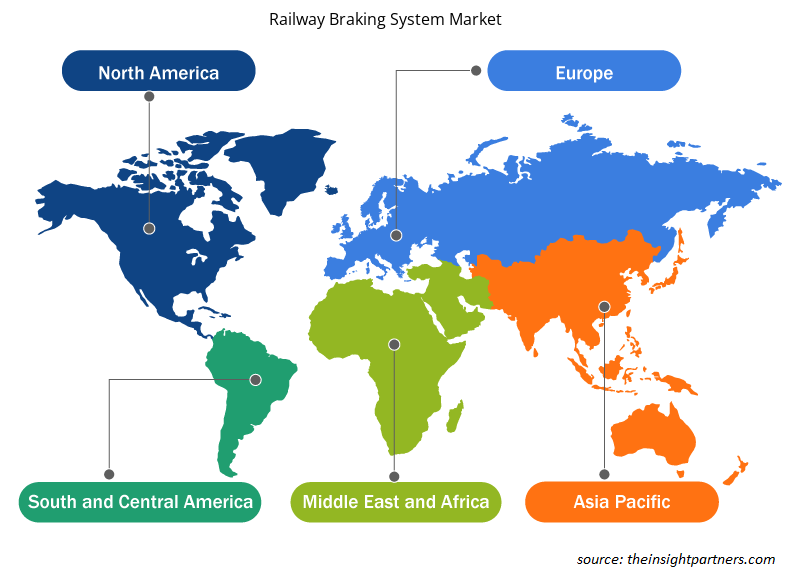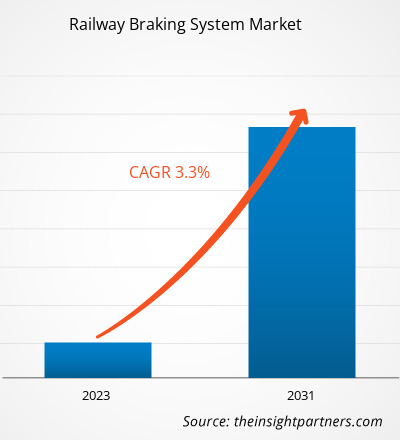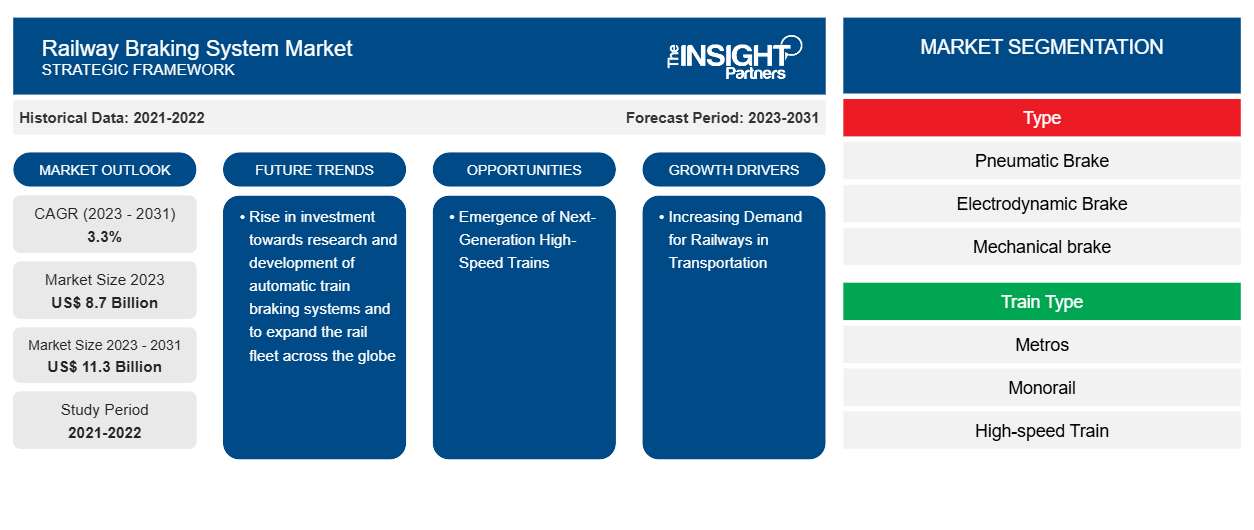Si prevede che la dimensione del mercato dei sistemi frenanti ferroviari raggiungerà 11,3 miliardi di dollari entro il 2031, rispetto agli 8,7 miliardi di dollari del 2023. Si prevede che il mercato registrerà un CAGR del 3,3% nel 2023-2031. L'aumento degli investimenti nella ricerca e nello sviluppo di sistemi frenanti automatici per treni e l'espansione della flotta ferroviaria in tutto il mondo sono tra le tendenze chiave che guidano il mercato dei sistemi frenanti ferroviari.
Analisi del mercato del sistema frenante ferroviario
Fattori come la crescente domanda di trasporto ferroviario tra gli individui come mezzo di trasporto e la crescita dei progetti ferroviari per la costruzione di nuove ferrovie e linee metropolitane, monorotaie e treni ad alta velocità. I progetti, uniti all'aumento degli investimenti governativi per l'espansione del settore ferroviario, continuano a rafforzare il settore ferroviario. Con l'aumento del settore ferroviario , l'ambito dell'integrazione dei sistemi di sicurezza, compresi i freni, sta ricevendo un forte slancio. Inoltre, l'arrivo di sistemi di frenata automatica dei treni, operazioni ferroviarie automatiche e treni ad alta velocità di nuova generazione nelle economie emergenti è un altro fattore che attira la crescita del mercato dei sistemi di frenata. Inoltre, il crescente numero di pacchetti di volume e il commercio nelle nazioni sta influenzando l'uso delle ferrovie, in quanto è il mezzo di trasporto più economico rispetto alle linee aeree. Pertanto, il boom del trasporto merci, anche il ciclo di sviluppo del trasporto merci su rotaia è aumentato. Con il crescente sviluppo della metropolitana leggera, aumenterà anche l'integrazione dei sistemi di frenata.
Panoramica del mercato dei sistemi frenanti ferroviari
Alla luce di megatrend chiave come sostenibilità, urbanizzazione, veicoli per la mobilità e digitalizzazione , il settore dei trasporti sta assistendo a una crescita enorme. Le tendenze sopra menzionate andranno a beneficio del settore ferroviario offrendo opportunità di crescita sostenibile a lungo termine per la mobilità futura. Inoltre, grazie ai rigorosi standard di sicurezza e qualità coinvolti nel settore ferroviario, l'integrazione di sistemi e attrezzature avanzati è in aumento. Nel settore ferroviario, i binari con doppio fissaggio elastico, guida automatizzata , cavi di alimentazione aerei/terza rotaia e sistemi di segnalazione di controllo dei treni basati sulle comunicazioni sono tra le poche tecnologie che vengono integrate nelle linee della metropolitana. L'incorporazione di tali tecnologie avanzate nelle rotaie della metropolitana svolgerà un ruolo essenziale nell'aumentare la portata dell'integrazione dei sistemi di frenatura delle rotaie.
Personalizza questo report in base alle tue esigenze
Riceverai la personalizzazione gratuita di qualsiasi report, comprese parti di questo report, o analisi a livello nazionale, pacchetto dati Excel, oltre a usufruire di grandi offerte e sconti per start-up e università
-
Scopri le principali tendenze di mercato in questo rapporto.Questo campione GRATUITO includerà analisi di dati che spaziano dalle tendenze di mercato alle stime e alle previsioni.
Driver e opportunità del mercato dei sistemi frenanti ferroviari
Crescente domanda di ferrovie nei trasporti
Il trasporto ferroviario è considerato principalmente un mezzo di trasporto sicuro, protetto ed economico rispetto al trasporto su strada. Per quanto riguarda fattori quali elevata precisione e capacità di coprire un'area geografica massima, la domanda tra i viaggiatori è in crescita. Per garantire la sicurezza di treni, merci e passeggeri, i sistemi frenanti sono tra i sistemi utilizzati sulle ferrovie. Inoltre, progetti governativi come la metropolitana Dubai Route 2020 per la costruzione di nuove infrastrutture ferroviarie e l'aumento degli investimenti per espandere la connettività ferroviaria stanno contribuendo alla crescita del settore ferroviario. Anche la domanda di ferrovie per il trasporto merci è in aumento. Con il crescente volume di pacchi e merci trasportati tramite ferrovie, il numero di treni è in aumento. Il massiccio trasporto di merci tramite ferrovie sta creando opportunità redditizie sia per i produttori di treni che per altri produttori di sistemi correlati ai treni. Pertanto, questo aspetto dell'aumento del trasporto merci e dei passeggeri ferroviari sta stimolando la crescita del settore ferroviario e motivando i governi dei paesi a investire massicciamente in progetti ferroviari.
Emersione dei treni ad alta velocità di nuova generazione
In un periodo di costanti progressi tecnologici, l'industria ferroviaria mondiale sta sperimentando nuove tecnologie e sistemi che stanno svolgendo un ruolo cruciale nella trasformazione dell'intero settore. Ad esempio, nell'aprile 2024, la Corea del Sud presenta un treno proiettile ad alta velocità di nuova generazione. Questo treno ha una velocità massima di 320 km/h. Inoltre, nell'ottobre 2023, la Francia ha presentato i suoi treni TGV M ad alta velocità di nuova generazione, la cui entrata in servizio è prevista per il 2025. Si prevede che tale progresso tecnologico e l'emergere di treni ad alta velocità in tutto il mondo guideranno la domanda per il mercato dei sistemi frenanti ferroviari durante il periodo di previsione.Kmph. In addition, in October 2023, France unveiled its next-generation high-speed TGV M trains, and is expected to be in service in 2025. Such technological advancement and the emergence of high-speed trains across the globe are projected to drive the demand for the railway braking system market during the forecast period.
Inoltre, l'avvento dei freni a disco ad aria di nuova generazione sta aprendo la strada alla trasformazione delle ferrovie. Inoltre, nel sistema di frenata diretta, i comandi dei freni vengono trasmessi rapidamente con un ritardo temporale più breve. Inoltre, Shift2Rail, un'impresa congiunta, sta lavorando a una soluzione di prova dei freni digitale, che consentirebbe ai macchinisti di testare i freni dalle loro cabine tramite un tablet. Questa soluzione di prova dei freni digitale aiuterebbe a risparmiare tempo e costi di manodopera, migliorando al contempo flessibilità e sicurezza. Nel periodo della mobilità di nuova generazione, l'emergere di treni ad alta velocità, soluzioni di prova dei freni digitali e freni di nuova generazione aiuterebbero a preparare il settore ferroviario per il futuro. Si prevede che tutti gli aspetti menzionati occuperanno una posizione significativa nell'adozione di sistemi di frenata ferroviari.
Analisi della segmentazione del rapporto di mercato del sistema frenante ferroviario
I segmenti chiave che hanno contribuito alla derivazione dell'analisi di mercato del sistema frenante ferroviario sono la tipologia e il tipo di treno.
- In base al tipo, il mercato dei sistemi frenanti ferroviari è stato suddiviso in freni pneumatici, freni elettrodinamici, freni meccanici e freni elettromagnetici. Il segmento dei pollici dei freni pneumatici ha detenuto una quota di mercato maggiore nel 2023.
- In base al tipo di treno, il mercato dei sistemi frenanti ferroviari è stato suddiviso in metropolitane, monorotaie, treni ad alta velocità, ferrovie leggere/tram e treni merci. Il segmento delle linee ferroviarie leggere/tram ha detenuto una quota di mercato maggiore nel 2023.
Analisi della quota di mercato del sistema frenante ferroviario per area geografica
L'ambito geografico del rapporto sul mercato dei sistemi frenanti ferroviari è suddiviso principalmente in cinque regioni: Nord America, Europa, Asia Pacifico, Medio Oriente e Africa e Sud America.
L'Asia Pacifica dominerà il mercato dei sistemi frenanti ferroviari nel 2023. La regione Asia Pacifica comprende Australia, Cina, Giappone, India, Corea del Sud e il resto dell'Asia Pacifica. Le economie stabili e i progressi tecnologici supportano la crescita di una gamma diversificata di settori e mercati nella regione. La connettività della rete ferroviaria regionale nella regione del Sud-est asiatico sta migliorando grazie all'implementazione di diversi progetti per collegare le rotte esistenti sotto la rete ferroviaria Pan Asia. Nuovi progetti ferroviari supportati e pianificati dal governo cinese garantirebbero collegamenti tra le principali città del continente del Sud-est asiatico, che si estendono da Kunming in Cina a Bangkok, Singapore e Kuala Lumpur, con una linea centrale da Vientiane in Laos a Bangkok; una linea orientale attraverso Hanoi City e Ho Chi Minh City in Vietnam e Phnom Penh City in Cambogia; e una linea occidentale attraverso Yangon in Myanmar.
Anche Indonesia e Filippine hanno pianificato progetti ferroviari per collegare città chiave con le loro isole principali. I settori ferroviari di Filippine, Thailandia, Cina e India stanno facendo enormi investimenti nei rispettivi territori per rafforzare il trasporto ferroviario integrando tecnologie avanzate. Inoltre, il Giappone è tra i principali paesi che stanno utilizzando treni ad alta velocità per ridurre la congestione sulle strade e aiutare i passeggeri a risparmiare tempo e denaro.
Approfondimenti regionali sul mercato dei sistemi frenanti ferroviari
Le tendenze regionali e i fattori che influenzano il Railway Braking System Market durante il periodo di previsione sono stati ampiamente spiegati dagli analisti di Insight Partners. Questa sezione discute anche i segmenti e la geografia del Railway Braking System Market in Nord America, Europa, Asia Pacifico, Medio Oriente e Africa e Sud e Centro America.

- Ottieni i dati specifici regionali per il mercato dei sistemi frenanti ferroviari
Ambito del rapporto di mercato del sistema frenante ferroviario
| Attributo del report | Dettagli |
|---|---|
| Dimensioni del mercato nel 2023 | 8,7 miliardi di dollari USA |
| Dimensioni del mercato entro il 2031 | 11,3 miliardi di dollari USA |
| CAGR globale (2023-2031) | 3,3% |
| Dati storici | 2021-2022 |
| Periodo di previsione | 2023-2031 |
| Segmenti coperti |
Per tipo
|
| Regioni e Paesi coperti |
America del Nord
|
| Leader di mercato e profili aziendali chiave |
|
Densità degli attori del mercato: comprendere il suo impatto sulle dinamiche aziendali
Il mercato del sistema frenante ferroviario sta crescendo rapidamente, spinto dalla crescente domanda degli utenti finali dovuta a fattori quali l'evoluzione delle preferenze dei consumatori, i progressi tecnologici e una maggiore consapevolezza dei vantaggi del prodotto. Con l'aumento della domanda, le aziende stanno ampliando le loro offerte, innovando per soddisfare le esigenze dei consumatori e capitalizzando sulle tendenze emergenti, il che alimenta ulteriormente la crescita del mercato.
La densità degli operatori di mercato si riferisce alla distribuzione di aziende o società che operano in un particolare mercato o settore. Indica quanti concorrenti (operatori di mercato) sono presenti in un dato spazio di mercato in relazione alle sue dimensioni o al valore di mercato totale.
Le principali aziende che operano nel mercato dei sistemi frenanti ferroviari sono:
- DAKO-CZ
- Azienda produttrice di freni Akebono.
- Ferrovia di Amsted
- Knorr-Bremse AG
- Società Nabtesco
- Servizi ferroviari Sabre Ltd
Disclaimer : le aziende elencate sopra non sono classificate secondo un ordine particolare.

- Ottieni una panoramica dei principali attori del mercato dei sistemi frenanti ferroviari
Notizie di mercato e sviluppi recenti del sistema frenante ferroviario
Il mercato dei sistemi frenanti ferroviari viene valutato raccogliendo dati qualitativi e quantitativi dopo la ricerca primaria e secondaria, che include importanti pubblicazioni aziendali, dati associativi e database. Di seguito è riportato un elenco degli sviluppi nel mercato dei sistemi frenanti ferroviari e delle strategie:
- Nel gennaio 2024, Wabtec Corporation ha ordinato un sistema frenante da 157 milioni di dollari USA da Siemens India Private Limited. Attraverso questo accordo di fornitura, Siemens Limited fornirà sistemi frenanti con prestazioni operative, efficienza e sicurezza migliorate per la nuova linea di 1.200 locomotive elettriche.
- Nell'ottobre 2023, Siemens Mobility ha lanciato un nuovo sistema frenante senza aria. Questo nuovo sistema frenante consente il controllo elettrico completo del freno a frizione nei veicoli ferroviari e rafforza il portafoglio prodotti dell'azienda.
Copertura e risultati del rapporto sul mercato dei sistemi frenanti ferroviari
Il rapporto "Dimensioni e previsioni del mercato dei sistemi frenanti ferroviari (2021-2031)" fornisce un'analisi dettagliata del mercato che copre le seguenti aree:
- Dimensioni e previsioni del mercato a livello globale, regionale e nazionale per tutti i segmenti di mercato chiave coperti dall'ambito
- Dinamiche di mercato come fattori trainanti, vincoli e opportunità chiave
- Principali tendenze future
- Analisi dettagliata delle cinque forze di Porter
- Analisi di mercato globale e regionale che copre le principali tendenze di mercato, i principali attori, le normative e gli sviluppi recenti del mercato
- Analisi del panorama industriale e della concorrenza che copre la concentrazione del mercato, l'analisi della mappa di calore, i principali attori e gli sviluppi recenti
- Profili aziendali dettagliati con analisi SWOT
- Analisi storica (2 anni), anno base, previsione (7 anni) con CAGR
- Analisi PEST e SWOT
- Valore/volume delle dimensioni del mercato - Globale, Regionale, Nazionale
- Industria e panorama competitivo
- Set di dati Excel
Report recenti
Testimonianze
Motivo dell'acquisto
- Processo decisionale informato
- Comprensione delle dinamiche di mercato
- Analisi competitiva
- Analisi dei clienti
- Previsioni di mercato
- Mitigazione del rischio
- Pianificazione strategica
- Giustificazione degli investimenti
- Identificazione dei mercati emergenti
- Miglioramento delle strategie di marketing
- Aumento dell'efficienza operativa
- Allineamento alle tendenze normative























 Ottieni un campione gratuito per - Mercato dei sistemi frenanti ferroviari
Ottieni un campione gratuito per - Mercato dei sistemi frenanti ferroviari